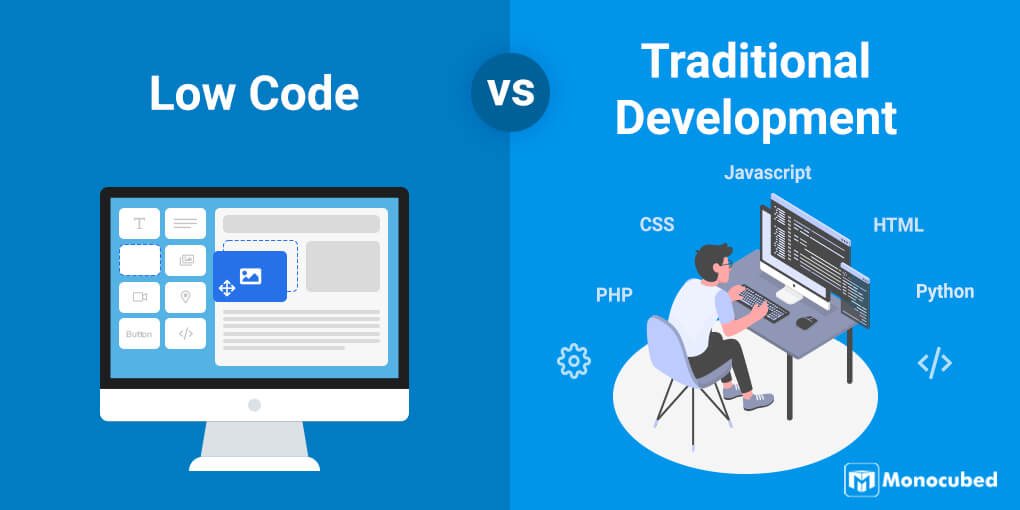Recommended Advice To Selecting Low-Code Platform Recommendations
Wiki Article
Benefits Of Low-Code Application Development Terms Of Speed
Visual Development Environment:
Drag-and-Drop Interfaces: Low-code platforms provide visual tools for designing applications. Developers can make use of drag-and-drop elements to create applications quickly and without writing extensive code.
Pre-built Templates and Components A lot of low-code platforms have templates and components that are pre-built, which enable developers to swiftly develop and test applications without starting from starting from scratch.
Coding Requirements Reduced
Automated code generation: Low-code systems create the underlying codes based on the visual models developed and maintained by programmers. This eliminates the need for manual code writing and speed up the process of developing.
Reusable Components : Developers can reuse components across different projects, thereby reducing the amount of time needed to write and testing code.
Collaboration is simplified:
Low-code platform tools usually include versions control, testing, or deployment. This facilitates seamless collaboration between teams.
Citizen Development (Citizen Development): Users and non-developers of business applications are able to participate in the development of applications using user-friendly interfaces. This helps to reduce the bottleneck caused by the limited accessibility of professional developers.
Rapid Iteration & Prototyping
Fast Prototyping : Developers create prototypes quickly to test ideas and collect feedback. This can result in a faster iteration cycles.
Easy Modifications: The visually-oriented design of low-code programming makes it easy to make changes and updates to applications, which speeds up the process of refining and improving applications based on user feedback.
Pre-built Integrations:
API Integrations Low-code platforms include prebuilt connectors that are compatible with popular services or APIs. They cut down the time it takes to integrate external applications.
Data Integration: The integrated tools simplify the process of connecting to databases and other sources, speeding development.
Scaling, deployment and deployment
One-Click Installation: Many low-code platforms have the option of installing with one click that reduces the amount of work and time required to install software.
Cloud-Based Solutions: Cloud-based low-code platforms are able to handle scaling and infrastructure management which allows developers to concentrate on application logic and functionality rather than the logistics of deployment.
Overall, the benefit of developing applications using low-code in terms speed lies in its ability to automatize and simplify many elements of the process, enabling rapid delivery of apps and faster adaptation to the changing demands. Take a look at the top Low-code Platform for application development for site tips including push notifications android, develop cross platform mobile app, develop mobile application, develop web app, push alerts, develop mobile application, mobile app development platforms, azure sql server, push alerts, application modernization software and more.

The Cost-Effectiveness Of Low-Code Development Is One Of The Main Advantages.
Low-code app development offers many advantages, including cost-effectiveness. It is a popular option for businesses who want to maximize their development budgets without compromising on quality. Here are a few of the most important advantages:
The low-code platform eliminates the need for lengthy manual coding. This reduces time and effort on the part of developers when developing their applications. This results in lower labor costs.
A smaller number of developers: Since low code development is faster and simpler to develop, there are less specialized developer resources required. This will significantly cut down on the cost of hiring and staffing.
More Time To Market
Accelerated development cycles Visual development tools and prebuilt components that are provided by low-code platforms enable rapid application development. This allows companies to bring their products launch faster. This will result in faster revenue generation and better position in the marketplace.
Rapid Prototyping. Through the rapid creation and testing prototypes, businesses can cut down on time spent development and iterate faster based upon user feedback.
Lower Maintenance Costs
Because of their modularity and common components, applications developed on low-code platforms tend to be easier to maintain. This will reduce the cost of ongoing maintenance and support.
Automated Patches and Updates: Low-code platforms can manage updating and patching applications automatically. This ensures that your application remains secure and always up to date without extensive manual intervention.
Efficient Resource Utilization:
Contributions from non-developers Low-code platforms enable non-developers and business users to be involved in the development process. This democratization enables businesses to take advantage of the skillsets of a wide variety of employees.
Optimized IT Resource Use IT departments will be able concentrate on strategic initiatives, rather than being buried in mundane development tasks. This will boost overall productivity and efficiency.
Price models that are scaleable:
Subscription Pricing: Many platforms with low-code offer flexible pricing models based on subscriptions which are scalable according to the amount of usage. This lets businesses align their spending with the actual requirements and expansion, while avoiding huge upfront expenses.
Pay-as-you-go: Certain platforms provide pay-as-you-go options. This lets businesses only pay for the resources they actually use. This is especially beneficial for small and new businesses with a limited budget.
Reduce the cost of third-party software:
Low-code platforms are often equipped with functions that are integrated, eliminating the requirement to purchase additional software or tools. This can help you save cash on subscriptions and licensing costs.
Pre-Built Intergrations: The availability and pre-built integrations with popular systems and services reduces the need for custom development and saves time and money.
Improved ROI
A faster return on investment: The combination of rapid development, lower costs, and faster time to market means businesses can achieve a faster return on investment (ROI) for their apps.
Improved Agility. Businesses are able to adjust quickly to the evolving market conditions and consumer needs. This helps them remain relevant, and will be able to profit from any new opportunities.
Train for Less:
User-Friendly Interfaces: The nimble, user-friendly interfaces of low-code platforms can reduce the learning curve for novice users, eliminating the requirement for lengthy training programs.
Accessible Resources A lot of low-code platforms provide complete instructional materials, tutorials as well as community support, reducing the requirement for formal education and the associated expenses.
Collaboration can be made easier.
Enhanced Collaboration Tools : The collaboration tools integrated into the software aid in collaboration and communication between the team members. This leads to an efficient development process and lower overhead.
Unified Development Environment. An unified development platform can help reduce costs and streamline workflows by reducing the complexities of managing various tools.
Low-code development is cost effective because it decreases maintenance and development expenses. It also speeds up the time to market and maximizes resource usage. Pricing models can be adapted. These factors combine to deliver significant financial benefits for businesses and make low-code development a viable choice for organizations aiming to maximize their development budgets while achieving robust, scalable, and high-quality applications. View the most popular Enterprise application development with Low-code Platform recommendations for site recommendations including rapid application design, rapid applications, app development platform, develop web app, rapid applications, app dev platform, application modernisation, lowcode no code, microsoft azure sql, azure sql server and more.

Benefits Of Low-Code Application Development In Terms Of Collaboration And Workflow
Low-code development offers many benefits in collaboration and workflow. This is why it is a perfect option for companies looking to increase productivity and speed up the process of development. These are the main advantages: Improved Collaboration Across Functions:
Unified Development Environment: Low-code platforms provide a single, unifying environment in which all team members comprising developers, business analysts, designers, and others, can collaborate effectively. This helps reduce the number of silos, as well as improves communication.
Visual Development Tools: The graphic, drag-and-drop nature of low-code tools makes it simpler for team members who are not technical to take part in the development process, ensuring that business requirements are accurately identified and implemented.
Communication Improved:
Real-Time Collaboration Many low-code applications offer real-time capabilities, like editing and commenting simultaneously, or instant feedback. This allows for constant communication and can help reduce the amount of time wasted in a back and forth discussion.
Shared Workspaces : Teams are able to work in shared workspaces. They can view edit, discuss and even discuss project components. This ensures that everyone has the same goal.
A streamlined workflow management system:
Built-In Tools for Project Management: Platforms that are low-code often come with integrated project management tools that aid teams in planning to track and manage their development initiatives. This includes tasks management, progress tracking and management of deadlines.
Automation of repetitive workflows and tasks can reduce the chance of errors and manual work that allows individuals and teams to focus more on strategic projects and increase efficiency.
Faster Iteration Cycles
Rapid Prototyping Low-code platforms are perfect for rapid prototyping. Iterative development is also possible and allows teams to develop, test and refine their software within shorter time. This provides rapid feedback and further improvement.
Agile Development Support Supporting agile methodology allows individuals and teams to work in small steps. It also makes it possible to quickly adapt to changes.
Accessibility for non-developers
Citizen Development - Low-code platforms give business users the ability to design and edit apps without coding expertise. This frees IT and development teams of the burden and allows faster responses to business needs.
Training and Onboarding - Intuitive interfaces, extensive training materials, and intuitive interfaces make it easier for new team members get familiar with the system and boost the overall team's cooperation.
Centralized Documentation, Knowledge Sharing and Information Sharing
Integrated Documentation: Low-code platforms provide a variety of features that allow for the creation and maintenance of documents on the platform. This makes sure that all information related to the project is accessible and centrally stored.
Knowledge Repositories. Teams can create repository of knowledge, with templates and parts that can be reused. This will help facilitate knowledge sharing and decrease duplicate work.
Consistency Standardization, Consistency and Standards:
Standardized components: Using standardized, pre-built components provides uniformity across different applications which makes it simpler for teams to understand and work on different aspects of an undertaking.
Governance and Compliance - Built-in governance frames make sure that the creation of all applications conforms to the organizational standards as as regulatory standards. This helps reduce risks of non-compliance as well as ensure that applications comply with quality standards.
Feedback and Improvement Loops
Integrated Feedback Systems: Low-code platforms provide integrated feedback systems that allow users to offer feedback about the application. The feedback could later be utilized in the creation of those applications.
Continuous Improvement: The ability to quickly test deployment, change and deploy applications based on user feedback lets them be in alignment to the company's goals and users' requirements.
Visualization and Reporting
Real-Time Analytics: Built-in analytics and reporting tools provide real-time insights into the progress of projects, their performance and user interaction that allow data-driven decision-making.
Visual Workflow Analysis Visual tools are used to show workflows and processes. These tools assist teams identify and improve their workflows.
Low-code development of applications is a powerful tool for collaboration and workflow. It connects different teams, improves communication, and streamlines processes. This promotes a more agile, collaborative and efficient environment for development. This eventually leads to better quality applications as well as better alignment of business objectives.
